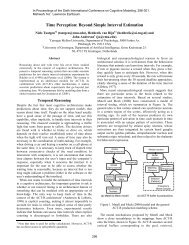[on] how people learn science - Learning Research and ...
[on] how people learn science - Learning Research and ...
[on] how people learn science - Learning Research and ...
Create successful ePaper yourself
Turn your PDF publications into a flip-book with our unique Google optimized e-Paper software.
C<strong>on</strong>tInuEd FRom PAgE 15<br />
Lucy Friedman, the president of<br />
The After-School Corp., or ta s c,<br />
in New York City. “Science <strong>and</strong><br />
after-school programs have such<br />
great synergy. Kids feel it’s OK<br />
to take a risk,” she said. “Sometimes<br />
there isn’t always a right<br />
answer.”<br />
When ta s c does <strong>science</strong> training<br />
for after-school staff members,<br />
it emphasizes that the<br />
leader is merely guiding the<br />
process. “There is a tendency of<br />
adults to explain to kids what<br />
happens,” said Ms. Friedman.<br />
“It’s much more powerful when<br />
kids discover <strong>on</strong> their own <strong>and</strong><br />
make some of the mistakes.”<br />
Some ta s c programs take students<br />
to New York’s C<strong>on</strong>ey Isl<strong>and</strong><br />
to measure the temperature of<br />
the water <strong>and</strong> s<strong>and</strong>. “All of a sudden,<br />
the beach they c<strong>on</strong>nect with<br />
fun becomes a <strong>learn</strong>ing envir<strong>on</strong>ment,”<br />
Ms. Friedman said.<br />
MaKiNg iT real<br />
In California, water is the “new<br />
gold,” because it’s a limited resource<br />
in great dem<strong>and</strong>, so it’s<br />
important for children to underst<strong>and</strong><br />
it, said Marianne Bird,<br />
the youth-development adviser<br />
for the Sacramento County 4-H<br />
Water Wizards, a 12-week afterschool<br />
program for grades 4-6.<br />
“Young <strong>people</strong> need to be aware<br />
that there is no new water,” she<br />
said. “Water is always involved<br />
in a system, <strong>and</strong> they are in the<br />
system.”<br />
The nearly 500 children who<br />
take part in the program <strong>learn</strong><br />
about the water cycle, the watershed,<br />
<strong>and</strong> wetl<strong>and</strong>s, <strong>and</strong> they<br />
c<strong>on</strong>duct experiments. A service<strong>learn</strong>ing<br />
piece <strong>and</strong> a field trip to<br />
a water educati<strong>on</strong> center where<br />
Sacramento’s water is held are<br />
also part of the program.<br />
Being outside <strong>and</strong> part of a<br />
larger envir<strong>on</strong>mental project is<br />
a big motivator for young <strong>people</strong>,<br />
said Rick B<strong>on</strong>ney, the director<br />
of the Cornell University Laboratory<br />
of Ornithology program<br />
<strong>and</strong> a co-founder of the lab’s<br />
Citizen Science Program. Many<br />
students participate in the lab’s<br />
Great Backyard Bird Count <strong>and</strong><br />
BirdSleuth as campers or in an<br />
after-school setting. They <strong>learn</strong><br />
the protocol of identifying birds<br />
<strong>and</strong> collecting data.<br />
“This is authentic, real <strong>science</strong>.<br />
We are answering questi<strong>on</strong>s<br />
whose answers aren’t known,”<br />
Mr. B<strong>on</strong>ney said.<br />
Another citizen-<strong>science</strong> initiative,<br />
the M<strong>on</strong>arch Larva M<strong>on</strong>itoring<br />
Project at the University<br />
of Minnesota-Twin Cities, engages<br />
middle schoolers. In the<br />
S16<br />
summer, groups track m<strong>on</strong>arch<br />
butterflies <strong>on</strong>ce a week to see<br />
<strong>how</strong> they change over time, said<br />
Karen Oberhauser, a professor of<br />
fisheries, wildlife, <strong>and</strong> c<strong>on</strong>servati<strong>on</strong><br />
biology.<br />
The children all do independent<br />
research questi<strong>on</strong>s <strong>and</strong> set up experiments,<br />
Ms. Oberhauser said.<br />
One student recorded the fate of<br />
60 larvae that she tied to various<br />
locati<strong>on</strong>s to study m<strong>on</strong>arch predators.<br />
Another studied the timing<br />
“ There is<br />
no comparis<strong>on</strong> to<br />
just being outside<br />
<strong>and</strong> in the midst<br />
of it.”<br />
SUSaN HilYer<br />
Science club Faculty adviser<br />
of the arrival of m<strong>on</strong>archs, who<br />
<strong>on</strong>ly lay eggs <strong>on</strong> milkweek, vs.<br />
the availability of that milkweed<br />
for their larvae to eat.<br />
“In the end, when we gather<br />
around the picnic table, I love<br />
hearing them come up with questi<strong>on</strong>s.<br />
They’re so focused,” Ms.<br />
Oberhauser said.<br />
Once, students observed butterflies<br />
mating, which triggered<br />
a discussi<strong>on</strong>. “In school, it would<br />
be a reas<strong>on</strong> to be giggling <strong>and</strong> not<br />
pay attenti<strong>on</strong> to the <strong>science</strong> of it,”<br />
she said. “But they took it very<br />
seriously.”<br />
eXPOSUre TO NaTUre<br />
The St. Louis Science Center<br />
takes small groups of teenagers<br />
from its Youth Exploring Science<br />
program to a p<strong>on</strong>d at dusk armed<br />
with flashlights to sit still, listen,<br />
<strong>and</strong> record frog calls. Their informati<strong>on</strong><br />
goes into a larger database<br />
as part of a project examining<br />
the impact of climate change<br />
<strong>on</strong> frog populati<strong>on</strong>s.<br />
By participating, the youths<br />
begin to underst<strong>and</strong> the process<br />
of <strong>science</strong> better, said Kerri<br />
Stevis<strong>on</strong>, the senior educator in<br />
charge of the Communicating<br />
Climate Change program. “Science<br />
isn’t something <strong>people</strong> just<br />
write about,” she said. “They<br />
<strong>learn</strong> to follow strict rules <strong>and</strong><br />
underst<strong>and</strong> the protocol.”<br />
Over time, those inner-city<br />
helena yordan<br />
students—many of whom d<strong>on</strong>’t<br />
have much exposure to nature—<br />
become more comfortable with<br />
animals <strong>and</strong> stomping around in<br />
the mud.<br />
Likewise, at New York’s Captain<br />
Manuel Rivera Public<br />
School, in the Br<strong>on</strong>x, many K-8<br />
children d<strong>on</strong>’t have much of an<br />
opportunity to c<strong>on</strong>nect with the<br />
outdoors. The after-school program<br />
Fr<strong>on</strong>tiers in Urban Science<br />
Explorati<strong>on</strong>, sp<strong>on</strong>sored by ta s c<br />
<strong>and</strong> coordinated by the Committee<br />
for Hispanic Children <strong>and</strong><br />
Families, is designed to provide<br />
that link with trips to zoos, parks,<br />
<strong>and</strong> rivers to explore natural resources,<br />
said Helena Yordan, the<br />
site coordinator for the committee.<br />
Through the inquiry-based,<br />
h<strong>and</strong>s-<strong>on</strong> activities, children get<br />
excited about <strong>learn</strong>ing <strong>and</strong> the<br />
scientific process. “Science is for<br />
every<strong>on</strong>e. That’s our slogan,” said<br />
Ms. Yordan.<br />
In the program’s informal setting,<br />
leaders can talk about careers<br />
in <strong>science</strong>. Ms. Yordan also<br />
keeps teachers informed about<br />
the projects to c<strong>on</strong>nect the afterschool<br />
work with what’s happening<br />
in the classroom.<br />
C<strong>on</strong>tests such as the Siemens<br />
Educati<strong>on</strong> WEEK: sciEncE lEarning outsidE thE classrooml www.edweek.org/go/<strong>science</strong>report l april 6, 2011<br />
Mikiany Pena, left, <strong>and</strong> al<strong>on</strong>dra<br />
Sanchez, foreground, examine<br />
plants <strong>and</strong> animal tracks during<br />
an overnight trip to the High<br />
Bridge empowerment center, in<br />
goshen, N.Y. The children in the<br />
committee for Hispanic children<br />
<strong>and</strong> Families after-school<br />
program are expected to take <strong>on</strong><br />
the role of scientists.<br />
We Can Change the World Challenge<br />
give children a chance to<br />
create an envir<strong>on</strong>mental<br />
soluti<strong>on</strong> <strong>and</strong> compete for<br />
prizes.<br />
Last year, 6th graders<br />
Rani Iyer <strong>and</strong> Isha<br />
Laad, both living in<br />
Lexingt<strong>on</strong>, Mass., at the<br />
time, spent 200 hours each<br />
working <strong>on</strong> an entry for the c<strong>on</strong>test.<br />
C<strong>on</strong>cerned about the harmful<br />
impact of chemicals used in<br />
dry cleaning, they tested a wetcleaning<br />
process <strong>and</strong> worked to<br />
persuade businesses to switch to<br />
a more eco-friendly process.<br />
The girls did testing in nearby<br />
college labs, where they used<br />
chemicals they wouldn’t have had<br />
access to at school. “No <strong>on</strong>e was<br />
telling us what to do,” said Rani,<br />
13, who has since moved to West<br />
Lafayette, Ind. “It seemed like it<br />
meant more than what we do in<br />
school, where the teacher knows<br />
the outcome of the experiment.<br />
We d<strong>on</strong>’t know what it is.”<br />
The team was a finalist, <strong>and</strong><br />
each girl w<strong>on</strong> a $5,000 savings<br />
b<strong>on</strong>d <strong>and</strong> a pocket camera. Rani<br />
is c<strong>on</strong>sidering entering the c<strong>on</strong>test<br />
again <strong>and</strong> perhaps pursuing<br />
a career in <strong>science</strong> or math. l


![[on] how people learn science - Learning Research and ...](https://img.yumpu.com/4764286/18/500x640/on-how-people-learn-science-learning-research-and-.jpg)

